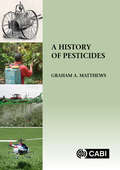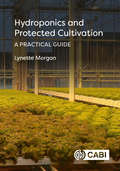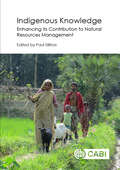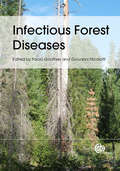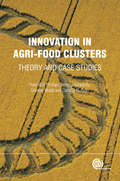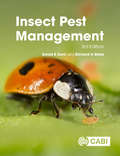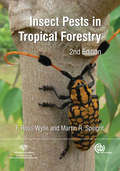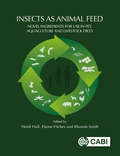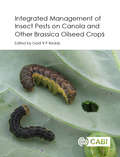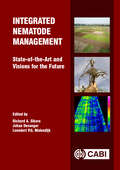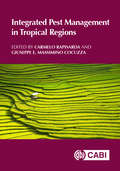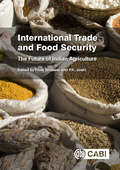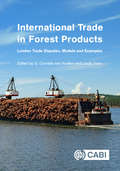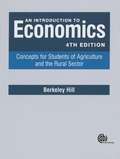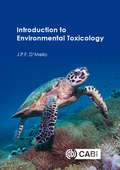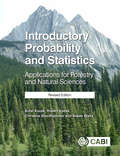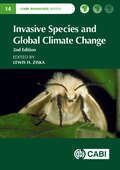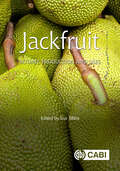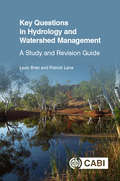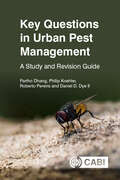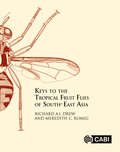- Table View
- List View
A History of Pesticides
by Graham MatthewsIn this fascinating book, Graham Matthews takes the reader through the history of the development and use of chemicals for control of pests, weeds, and vectors of disease and then discusses their future.
Hydroponics and Protected Cultivation: A Practical Guide
by Dr Lynette MorganA comprehensive, practical text which covers a diverse range of hydroponic and protected cropping techniques, systems, greenhouse types and environments. It also details the use of indoor plant factories, vertical systems, organic hydroponics and aquaponics. Worldwide hydroponic cropping operations can vary from large, corporate producers running many hectares of greenhouse systems particularly for crops such as tomato, cucumber, capsicum and lettuce, to smaller-scale growers growing fresh produce for local markets. Included in this book: Detailed technical information to help growers and students to design and run their own hydroponic operations. In-depth research to explain the factors that influence plant growth, produce quality, post-harvest life and hydroponic plant nutrition. New advances such as the use of organic nutrients and substrates, completely enclosed indoor plant factories and the growing number of small-scale, non-commercial applications. Hydroponics and Protected Cultivation is fully illustrated with colour images and photographs to illustrate key topics and help identify problem areas. It is suitable for growers, researchers and students in horticulture.
Indigenous Knowledge: Enhancing its Contribution to Natural Resources Management (Indigenous Knowledge And Development Ser. #Vol. 39)
by Andrew Ainslie Kojo Amanor Jeff Bentley Samara Brock Stephen Brush David A. Cleveland Luisa Cortesi Michael R Dove Romain Duda Roy Ellen James Fairhead Álvaro Fernández-Llamazares James Fraser Sandrine Gallois Chris Hebdon Patricia Howard Samuel Guindo Sascha Huditz Amy Leigh Johnson Alder Keleman J Stephen Lansing Melissa Leach Rosalinda Hidalgo Ledesma Johannes Lehmann Francis Michael Ludlow Doyle McKey Citlalli López Binnqüist Paul Van Mele Tom Van Mourik Lars Otto Naess Florencia Palis Fortunata Panzo Panzo Victoria Reyes García Delphine Renard Gede Sedana Christopher Shepherd Professor Paul Sillitoe Daniela Soleri Dawit Solomon Sidi Toure Thérèse De Vet Wayan Windia Gérard ZoundjiIndigenous Knowledge (IK) reviews cutting-edge research and links theory with practice to further our understanding of this important approach's contribution to natural resource management. It addresses IK's potential in solving issues such as coping with change, ensuring global food supply for a growing population, reversing environmental degradation and promoting sustainable practices. It is increasingly recognised that IK, which has featured centrally in resource management for millennia, should play a significant part in today's programmes that seek to increase land productivity and food security while ensuring environmental conservation. By drawing together strands of biocultural diversity research into natural resources management, this book: - Provides an overview of conceptual issues around IK and its contributions to sustainable agriculture and environmental conservation; - Addresses key themes via case studies from bioculturally diverse regions of the world; - Displays a wide range of methodologies and outlines a possible agenda to guide future work. An invaluable resource for researchers and postgraduate students in environmental science and natural resources management, this book is also an informative read for development practitioners and undergraduates in agriculture, forestry, geography, anthropology and environmental studies.
Infectious Forest Diseases
by Michael Wingfield Paolo Capretti Paolo Gonthier Richard Hamelin J Stenlid Bernard Slippers Tadeusz Kowalski Robert Mathiasen Robert Edmonds Rimvydas Vasaitis Michael Ostry Thomas Kirisits Marieka Gryzenhout Thomas Harrington Kathy Lewis Caroline Mohammed Libor Jankovsk Rosie Bradshaw Naoto Kamata Matteo Garbelotto Helen Griffiths Thomas Cech William Otrosina Giovanni Nicolotti Lilja Arija Roberto Danti Jean Guillaumin Daniel RiglingToday, forest health and the management of threats towards it are attracting more and more attention on a global scale. This book covers the most recent advances in the management of forest diseases, including the epidemiology and infection biology of forest pathogens, and forest protection based on integrated pest and disease management approaches. A comprehensive range of diseases caused by viruses, bacteria, fungi and other organisms are discussed in detail, making this book essential reading for forest managers and extension specialists. Written by recognised authorities in the subject of forest health, this book also provides a wealth of information useful for researchers and lecturers of forest pathology and ecology.
Infectious Forest Diseases
by J Stenlid Robert Edmonds Lilja Arija Helen Griffiths Robert Mathiasen Naoto Kamata Jean Guillaumin Kathy Lewis Caroline Mohammed Rimvydas Vasaitis Thomas Harrington Thomas Kirisits William Otrosina Bernard Slippers Daniel Rigling Marieka Gryzenhout Roberto Danti Thomas Cech Michael Ostry Paolo Capretti Rosie Bradshaw Libor Jankovsk Tadeusz Kowalski Matteo Garbelotto Richard Hamelin Michael WingfieldToday, forest health and the management of threats towards it are attracting more and more attention on a global scale. This book covers the most recent advances in the management of forest diseases, including the epidemiology and infection biology of forest pathogens, and forest protection based on integrated pest and disease management approaches. A comprehensive range of diseases caused by viruses, bacteria, fungi and other organisms are discussed in detail, making this book essential reading for forest managers and extension specialists. Written by recognised authorities in the subject of forest health, this book also provides a wealth of information useful for researchers and lecturers of forest pathology and ecology.
Innovation in Agri-food Clusters
by Jeremy Karwandy Camille Ryan Peter Phillips Graeme WebbInnovation has moved through a range of revolutionary epochs, but there is no clear picture of how, or even if, innovation can be managed. This book explores the models, methods and metrics of innovation analysis in the context of a single centre: the Global Oilseeds Complex centred in Saskatoon, Canada. It is a single, coherent volume that outlines the theory and practices related to innovation, offering a critical assessment of the strengths and weaknesses of the different approaches, backed up with empirical evidence.
Insect Pest Management
by David Dent Dr Richard BinksAn undergraduate and postgraduate textbook covering the key principles, methodologies, approaches and practical examples of insect pest management in agricultural, post harvest systems, horticulture, insect vectors and medical and veterinary entomology. The book covers the underpinning monitoring and forecasting of pest outbreaks, yield loss and impact assessments and all of the latest methods of control and management of insects from insecticides, host manipulation, plant resistance, biological control, use of interference, agronomic and precision control methods as well as socio-economic and research management aspects of developing integrated approaches to pest management. The new edition also reflects the key advances made in the disciplines of molecular biology, biochemistry and genomics related to insects and their management, as well as the importance and role of biodiversity, climate change, precision agriculture, data management and sustainability of production and supply in delivering integrated management solutions.
Insect Pests in Tropical Forestry
by Dr Martin R Speight Dr F. Ross WylieThe management of tropical forest ecosystems is essential to the health of the planet. This book addresses forest insect pest problems across the world's tropics, addressing the pests' ecology, impact and possible approaches for their control. Fully updated, this second edition also includes discussions of new areas of interest including climate change, invasive species, forest health and plant clinics. This work is an indispensible resource for students, researchers and practitioners of forestry, ecology, pest management and entomology in tropical and subtropical countries.
Insects as Animal Feed: Novel Ingredients for Use in Pet, Aquaculture and Livestock Diets
by Amanda Beard Hanna Bjone Angela Booth John Brameld Syrine Chaalala Faki Chabi Olivia Champion Chistophe Chrysostome William Clark Victor Clottey Kalifa Coulibaly Emilie Devic Michael Dickinson David Drew Virginia Emery Norbert Erokotan Thomas Farrugia Mark Finke Mohamed Gastli Adin Y. Bloukounon-Goubalan Kerensa Hawkey Antoine Hubert Marc Kenis Gabriel Koko Liz Koutsos Lars-Henrik Lau Heckmann Sean Mason Helen Massey O'Neill James McCulloch Daniel Murta Judith Nelson Emmanuel Nkegbe Noel Obognon Dennis Oonincx Tim Parr Rajmond Percze Sètchémè Pomalégni Liz Quigley Santos Rojo Birgit Rumpold Aliou Saïdou Andrew Salter Istvan Sandor Fernand Sankara Katharina Unger Maureen Wakefield Luke Wheat Keiran WhitakerThe global drive towards sustainability and improved animal health means there is a greater need for development of novel functional ingredients for the feed industry. As the requirements for protein for livestock feed and human consumption grows, the use of insect products as animal feed has gained increasing attention. Covering global production systems of insect protein, oil and chitin, as well as co-products from this industry, this book: - Considers in-depth nutritional and safety aspects of insects for feed. - Reviews suitability of insects as feed for different animal species and life stages. - Examines current knowledge of the value of insect-rearing residues as biofertilizers for crop health. - Identifies the challenges related to regulation, legislation, consumer perception and acceptance, and commercialization of insects. - Provides interviews with established and early-stage innovative companies producing insect protein for feed. Including a focus on practices such as waste valorization, this book takes a holistic look at how insects could contribute to the sustainability of livestock production on a global scale. Providing an up-to-date reference for research scientists, nutritionists, and veterinarians, as well as prospective insect farmers, it will also be of interest to those with a broader curiosity towards climate change, sustainability, and the circular economy.
Integrated Management of Insect Pests on Canola and Other Brassica Oilseed Crops
by Gadi V.P. ReddyThis book comprehensively reviews current pest management practices and explores novel integrated pest management strategies in Brassica oilseed crops. It is essential reading for pest management practitioners and researchers working on pest management in canola and other Brassica crops worldwide. Canola, mustard, camelina and crambe are the most important oilseed crops in the world. Canola is the second largest oilseed crop in the world providing 13% of the world's supply. Seeds of these species commonly contain 40% or more oil and produce meals with 35 to 40% protein. However, its production has declined significantly in recent years due to insect pest problems. The canola pest complexes are responsible for high insecticide applications on canola. Many growers rely on calendar-based spraying schedules for insecticide applications. The diamondback moth Plutella xylostella and flea beetles Phyllotreta spp. (P. cruciferae and P. striolata)cause serious damage to canola. In the Northern Great Plains, USA, for instance, P. xylostella is now recorded everywhere that canola is grown. Severe damage to canola plants can be caused by overwintering populations of flea beetles feeding on newly emerged seedlings. Cabbage seed pod weevil (Ceutorhynchus obstrictus), swede midge (Contarinia nasturtii), and tarnished plant bug (Lygus lineolaris) are also severe pests on canola. Minor pests include aphids (cabbage aphid, Brevicoryne brassicae and turnip aphid, Hyadaphis erysimi) and grasshopper, Melanoplus sanguinipes. This book: #65533; is the only single compiled source of information on integrated management of canola and other Brassica oilseed pests #65533; presents the biology and management of all the major and minor pests of Brassica oilseed crops #65533; is an essential source of information for applied entomologists, crop protection researchers, extension agents and stakeholders
Integrated management of Insect Pests on Canola and other Brassica Oilseed Crops
by Harit K Bal Ronald E Batallas Tulsi Bhardwaj James D Blande Dhana Raj Boina G David Buntin Randall Brandt Hector Cárcamo Surendra Dara Tim J Dumonceaux Robert H Elliott Maya Evenden Yaghoub Fathipour Kevin D Floate John Gavloski Kristopher L Giles Larry Grenkow Parwinder Grewal Rebecca H Hallett Matthew P. Hill Vincent A Hervet Sari J. Himanen Heikki M.T. Hokkanen Jarmo K Holopainen Prashant Jha Peter Mason Janet J Knodel Tao Li Sarina Macfadyen Ingeborg Menzler-Hokkanen Mohammad Ali Mirhosseini Christine Noronha Chrystel Olivier Francisco Rubén Badenes-Pérez S. Jesu Rajan Tom Royer Muhammad Sarwar Barbara Sharanowski Govinda Shrestha Juliana Soroka Rajagopalbabu Srinivasan Raj Kumar Thakur Sally Vail Leyun Wang R W Wanigasekara Chaminda De Weeraddana Tyler J Wist Zi-Hua ZhaoThis book comprehensively reviews current pest management practices and explores novel integrated pest management strategies in Brassica oilseed crops. It is essential reading for pest management practitioners and researchers working on pest management in canola and other Brassica crops worldwide. Canola, mustard, camelina and crambe are the most important oilseed crops in the world. Canola is the second largest oilseed crop in the world providing 13% of the world's supply. Seeds of these species commonly contain 40% or more oil and produce meals with 35 to 40% protein. However, its production has declined significantly in recent years due to insect pest problems. The canola pest complexes are responsible for high insecticide applications on canola. Many growers rely on calendar-based spraying schedules for insecticide applications. The diamondback moth Plutella xylostella and flea beetles Phyllotreta spp. (P. cruciferae and P. striolata)cause serious damage to canola. In the Northern Great Plains, USA, for instance, P. xylostella is now recorded everywhere that canola is grown. Severe damage to canola plants can be caused by overwintering populations of flea beetles feeding on newly emerged seedlings. Cabbage seed pod weevil (Ceutorhynchus obstrictus), swede midge (Contarinia nasturtii), and tarnished plant bug (Lygus lineolaris) are also severe pests on canola. Minor pests include aphids (cabbage aphid, Brevicoryne brassicae and turnip aphid, Hyadaphis erysimi) and grasshopper, Melanoplus sanguinipes. This book: · is the only single compiled source of information on integrated management of canola and other Brassica oilseed pests · presents the biology and management of all the major and minor pests of Brassica oilseed crops · is an essential source of information for applied entomologists, crop protection researchers, extension agents and stakeholders
Integrated Nematode Management: State-of-the-Art and Visions for the Future
by John Mueller Andreas Westphal Pedro Luiz Pedro Luiz Martins Graham Stirling Jon Pickup Dr Danny Coyne Thomas Forge Professor Johannes Hallmann Horacio D. Lopez-Nicora Terry L. Niblack Richard W. Smiley Gregory L. Tylka Inga A. Zasada Sheila Storey Muhammad Amjad Ali Larry Duncan Dr Johan Desaeger Amer A Dababat Ravi Singh Abasola C. Simon Driekie Fourie John. W. Kimenju P. K. Wendo A. K. Thuo H S Gaur J. S. Prasad Nethi Somasekhar Prabashnie Ramouthar Andressa Cristina Machado Richard F Davis Robert C. Kemerait Kathy S. Lawrence Daniel Dalvan Nascimento Deliang Peng Edward Sikora Philip A Roberts Nicola Greco Zane Grabau Dr Patricia Timper Sonia Steenkamp Luis Pocasangre Soledad Verdejo-Lucas Joseph W. Noling Michael V. McKenry John M. Halbrendt Hans Hugo M. S Daneel W. P. Steyn Sônia Maria Salgado Willian C. Terra Raman K. Walia Nicola Sasanelli Miguel Talavera-Rubia J. Ole Becker Johnny Visser Brinkman D.D. Onion Wim M.L. Wesemael Bernd Augustin Pella Brinkman Misghina Goitom Teklu Saad L. Hafez Sundararaj Palanisamy Mikhail Pridannikov Ann. MacGuidwin Biodun Claudius-ColePlant parasitic nematodes are costly burdens of crop production, causing an estimated US$80 - 118 billion per year in damage to crops. They are associated with nearly every important agricultural crop, and are a significant constraint on global food security. Regulations on the use of chemical pesticides have resulted in growing interest in alternative methods of nematode control. Future changes in climate, cropping systems, food habits, as well as social and environmental factors also affect the options for nematode control. Taking a systematic crop by crop approach, this book: Outlines the economic importance of specific plant parasitic nematode problems on the major food and industrial crops. Presents the state-of-the-art management strategies that have been developed to reduce specific nematode impacts, and outlines their limitations. Contains case studies to illustrate impact in the field. Aims to anticipate future changes in nematode disease pressure that might develop as a result of climate change, and new cropping systems.
Integrated Pest Management in Tropical Regions
by Carmelo Rapisarda Giuseppe E. Massimino CocuzzaThis book provides up-to-date and comprehensive coverage of the research and application of Integrated Pest Management (IPM) in tropical regions. The first section explores the agro-ecological framework that represents the foundations of IPM, in addition to emerging technologies in chemical and biological methods that are core to pest control in tropical crops. The second section follows a crop-based approach and provides details of current IPM applications in the main tropical food crops (such as cereals, legumes, root and tuber crops, sugarcane, vegetables, banana and plantain, citrus, oil palm, tea, cocoa and coffee) and also fibre crops (such as cotton) and tropical forests. Integrated Pest Management in Tropical Regions: #65533; Explores the techniques aimed at controlling pests in agro-ecosystems sustainably while reducing secondary effects on the environment and on plant, animal and human health #65533; Contextualizes IPM within our current knowledge of climate change and the global movement of organisms #65533; Covers integrated strategies to contains pests in major tropical food crops, fibre crops and trees #65533; Discusses options and challenges for pest control in tropical agriculture
Integrated Pest Management in Tropical Regions (CABI Plant Protection Series)
by Tsedeke Abate Siti Ramlah Ali Miguel A. Altieri Salvatore Bella Dr Danny Coyne Mieke S. Daneel Fábio Maximiano Silva José Gilberto De Moraes Thomas Dubois Odair A Fernandes François-Régis Goebel Shoil M. Greenberg Devid Guastella Abdelhaq Hanafi Norman Kamarudin Fred Kanampiu Nitin Kulkarni James Legg George Mahuku Zulkefli Masijan Ramle Moslim Urbano Nava-Camberos Clara I. Nicholls Amin Nikpay Joshua Okonya Megha N. Parajulee Silvana V. Paula-Moraes Alexandre Specht Edison R. Sujii Mohd. Basri Wahid Vitalis Wafula Wekesa Everlyne WosulaThis book provides up-to-date and comprehensive coverage of the research and application of Integrated Pest Management (IPM) in tropical regions. The first section explores the agro-ecological framework that represents the foundations of IPM, in addition to emerging technologies in chemical and biological methods that are core to pest control in tropical crops. The second section follows a crop-based approach and provides details of current IPM applications in the main tropical food crops (such as cereals, legumes, root and tuber crops, sugarcane, vegetables, banana and plantain, citrus, oil palm, tea, cocoa and coffee) and also fibre crops (such as cotton) and tropical forests. Integrated Pest Management in Tropical Regions: · Explores the techniques aimed at controlling pests in agro-ecosystems sustainably while reducing secondary effects on the environment and on plant, animal and human health · Contextualizes IPM within our current knowledge of climate change and the global movement of organisms · Covers integrated strategies to contains pests in major tropical food crops, fibre crops and trees · Discusses options and challenges for pest control in tropical agriculture
International Trade and Food Security: The Future of Indian Agriculture
by Floor Brouwer P. K. JoshiThis book explores structural changes in India's agrifood systems during the next ten to twenty years. The dynamics in the agrifood sector is explored in the context of the overall economy, taking into account agricultural and trade policies and their impacts on national and global markets. The contributors draw on qualitative and quantitative approaches, using both a national model - to focus on urban-rural relations and income distribution - and an international model to focus on patterns of economic growth and international trade.
International Trade and Food Security: The Future of Indian Agriculture
by Floor Brouwer P. K. JoshiThis book explores structural changes in India's agrifood systems during the next ten to twenty years. The dynamics in the agrifood sector is explored in the context of the overall economy, taking into account agricultural and trade policies and their impacts on national and global markets. The contributors draw on qualitative and quantitative approaches, using both a national model - to focus on urban-rural relations and income distribution - and an international model to focus on patterns of economic growth and international trade.
International Trade in Forest Products: Lumber Trade Disputes, Models and Examples
by Joseph Buongiorno Jinggang Guo Craig Johnston Xintong Li Fatemeh Mokhtarzadeh Harry Nelson Prakash Nepal Jeffrey Prestemon Brad StennesBecause of the long-standing Canada-U.S. lumber trade dispute and the current pressure on the world's forests as a renewable energy source, much attention has been directed toward the modelling of international trade in wood products. Two types of trade models are described in this book: one is rooted in economic theory and mathematical programming, and the other consists of two econometric/statistical models--a gravity model rooted in theory and an approach known as GVAR that relies on time series analyses. The purpose of the book is to provide the background theory behind models and facilitate readers in easily constructing their own models to analyse policy questions that they wish to address, whether in forestry or some other sector. Examples in the book are meant to illustrate how models can be used to say something about a variety of issues, including identification of the gains and losses to various players in the North American softwood lumber business, and the potential for redirecting sales of lumber to countries outside the United States. The discussion is expanded to include other products besides lumber, and used to examine, for example, the effects of log export restrictions by one nation on all other forestry jurisdictions, the impacts of climate policies as they relate to the global forest sector, and the impact of oil prices on forest product markets throughout the world. This book will appeal to practising economists and researchers who wish to examine various policies that affect international trade, whether their interest is local or international in scope. Because the book provides the theoretical bases underlying various models, students and practitioners will find this a valuable reference book or supplementary textbook.
An Introduction to Economics
by Berkeley HillThis book provides a simple but effective introduction to economics. Fully updated and revised, this fourth edition incorporates the recent changes that have taken place in the environment in which agriculture operates. Covering the impacts of the EU expansion to 28 Member States, major changes to financial support of agriculture, financial crises, economic recession and, in many countries, high levels of unemployment, it provides a rounded and up to date introduction to the subject. The inclusion of chapter-focused exercises, essay questions and further reading suggestions make this textbook an invaluable learning tool for students of agriculture, economics and related sectors.
Introduction to Environmental Toxicology
by J P D'MelloIntroduction to Environmental Toxicology is designed as a concise text, introducing students to the fundamentals of this important subject. It covers the origin, characterization and environmental distribution of the major pollutants, and provides an explanation of their implications for human morbidity via the development of cancer, cardiovascular disease, pulmonary dysfunction and neurological conditions. Considering impacts on biodiversity, such as effects from acid rain, heavy metals and selected anthropogenic compounds, this book: - Covers biogenic contaminants, gases and particulates, organic pollutants, petroleum, heavy metals, complex polymers and radiation; - Considers the impact of pollutants across human health, biodiversity, water and food safety; - Includes questions, further reading and case studies to spark discussion in tutorials. Covering all the major biological toxins and pollutants, this book forms a true introduction to the subject for undergraduates studying environmental toxicology and related subjects.
Introductory Probability and Statistics: Applications for Forestry and Natural Sciences (Revised Edition)
by Robert Kozak Antal Kozak Christina Staudhammer Susan WattsAll students, practitioners and researchers in forestry and related disciplines need a good grounding in statistics and probability. This need is increasing as techniques for gathering and analysing large amounts of data are becoming commonplace. This revised edition of this unique textbook is specifically designed for statistics and probability courses taught to students of forestry and related disciplines. It introduces probability, statistical techniques, data analysis, hypothesis testing, experimental design, sampling methods, nonparametric tests and statistical quality control, using examples drawn from a forestry, wood science and conservation context. The book now includes several new practical exercises for students to practice data analysis and experimental design themselves. It has been updated throughout, and its scope has been broadened to reflect the evolving and dynamic nature of forestry, bringing in examples from conservation science, recreation and urban forestry. - Specifically written and designed to teach statistics and probability to students of forestry and related disciplines in the natural sciences - This revised edition has been broadened to reflect the dynamism of modern forestry -Chapters in this revised edition include new practical exercises allowing students to practice data analysis and experimental design
Invasive Species and Global Climate Change (CABI Invasives Series)
by Lewis H. ZiskaThis book addresses topics related to the impact of invasive species including biosecurity, demographics, species diversity and food security. It is meant for researchers, upper-level students, and policy makers and provides a factual basis for the underlying science and a discussion of that information with respect to current and future impacts and possible solutions. This book explores the nexus of climate change and biological invasions, resulting impacts (biological and economic) and assesses ways to reduce vulnerability and increase the resiliency and sustainability of managed and unmanaged ecosystems. The book has three parts, focusing on: (1) the dimensions of the problem; background and science; (2) case studies; (3) Management: detection, prevention, control and adaptation. This revised edition examines a wide range of topics and region, the underlying science, examples (case studies) from around the world, and ways and means to recognize, manage and control the consequences. It includes new cases and new threats; for example, a chapter summarizing case studies regarding climate change and invasive species that are also disease carriers (e.g. ticks and Lyme disease). - Covers a wide range of topics and areas - Examines the synergy between invasive species and climate change - Explains options to control and mitigate effects This book is of interest to academics, researchers and students studying climate change and invasive species. Those interested in the environment and ecology, land managers, policy makers, agronomists, federal and state departments of natural resources, climate change activists, public health professionals.
Jackfruit: Botany, Production and Uses (Botany, Production and Uses)
by Gundappa Baradevanal Jigzcel Divine Bassoy Anup K. Bhattacherjee Prakash C. Tripathi Michel Chauvet Phebe Ding David Guest Mathala Juliet Gupta Azimah Hamidon C. K. Harshita Hamizah Hassan Ganesan Karunakaran Kundan Kishore Mohamad Munirah Rosmah Murdad Pradyot K. Pathak Dinh Thi Phuong S. Rajendran Ankita Sahu Hari S. Singh A. Thirugnanavel Nor E Tajidin Mai Van Tri Josephine G. Tangonan M. Arivalagan Chalina K. Beneragama R.M.S. Ruwan Chamara V. Dileep D.M. Samantha Dissanayaka H.M. Prathibhani Kumarihami Asanga D. Nagalla D.K.N. Gamini Pushpakumara Pravat K. Ray T. Sakthivel P. M. Sampath Shyamalamma Subbareddy Valeeta Marina Dsouza H. V. VidyashreeJackfruit (Artocarpus heterophyllus), is a species of tree in the fig, mulberry, and breadfruit family (Moraceae) and is widely esteemed in tropical Asia. The jackfruit tree is well suited to tropical lowlands, and is widely cultivated throughout South and South-East Asia. It is also grown to a limited extent in Australia, USA, East Africa, as well as in Brazil, Mexico and the Caribbean. Producing giant fruits which can reach up to 80kg in size, jackfruit is the largest tree-borne fruit in the world. It is highly versatile, providing food, timber, fuel in addition to medicinal and industrial products. The ripe fruit is sweet and is more often used for desserts. Canned green jackfruit has a mild taste and meat-like texture that lends itself to being called a 'vegetable meat'. Hence, it is growing in popularity due to its use as a vegan meat alternative. The tree is a major component of subsistence and small-farming systems and the fruit often assumes the role of a secondary staple food as well as contributing to the livelihoods of the poor. Despite this, it is still an underutilized crop in many countries. Containing information on jackfruit production technology, postharvest management and processing, this is a valuable resource for researchers in horticulture, plant science, and those interested in sustainable food systems.
Key Questions in Hydrology and Watershed Management: A Study and Revision Guide (Key Questions)
by Professor Leon Bren Professor Patrick LaneThis book provides a series of exercises of various types covering matters of hydrology and watershed management. The exercises include true/false questions, multiple choice questions, and numeric, graphical, and analytical exercises. The questions draw on the basic disciplines of hydrology and physics, with some stress placed on correct or appropriate units. The questions reflect the authors' many years of teaching watershed management at undergraduate and graduate levels. Questions cover: 1. Terminology and measurement of flow (and units) 2. Quantifying stream networks 3. Concepts of water balance and evapotranspiration 4. Slope recharge, groundwater hydrology, and water-table/phreatic aquifers 5. Single and paired watershed experiments 6. Impacts of fires on watersheds 7. Concepts and measurements of water quality 8. Flooding forests 9. Valuation of water 10. Protection of forest stream by buffers 11. Urban watershed concepts The book is self-contained, and designed to be used at any time in any place, either for revision or as source material for teaching. The work is graded so that easier questions are presented early, followed by harder questions. Answers are concise but contain enough information to help students study and revise on a topic-by-topic basis. The book concludes with suggestions for student exercises and projects and is an invaluable resource for both students and instructors.
Key Questions in Urban Pest Management: A Study and Revision Guide (Key Questions)
by Partho Dhang Roberto Pereira Philip Koehler Dr Daniel Dye IIUrban pests are common all over the world. These include cockroaches, flies, mosquitoes, bed bugs, ticks, fleas, ants, termites, rodents and others. These pests thrive in human structures, where there is food, warmth and places to hide. Urban pests are one of the leading causes of illnesses in humans due to allergies, bites, food contamination and phobias. They can also cause significant damage to property and structures. Knowledge and training in this field is vital for professional and trainee pest managers. This book is specifically intended to provide an aid to such candidates. The book contains 500 multiple-choice questions (and answers) grouped into the following major topic areas: · The history of urban entomology · Household pests · Cockroaches · Flies · Mosquitoes · Bed bugs · Termites · Sporadic pests · Stored product pests · Vertebrate pests · Pesticides and pesticide formulations · Handling pesticides · Integrated Pest Control Produced in a convenient format that can be used at any time in any place, the book allows the reader to learn and revise the subject and much more. Its structure allows the study of one topic area at a time, progressing through a simple introduction followed by key revision questions, many of which require students to use their practical knowledge. The answers to each of the questions are provided at the end with short explanations wherever appropriate.
Keys to the Tropical Fruit Flies (Tephritidae: Dacinae) of South-East Asia
by Richard A. I. Drew Meredith C. RomigFruit flies are a major issue facing horticultural producers, and as global warming and species migration become more prevalent issues there is an urgent need for easy identification of these pests. A companion volume to the recently published "Tropical Fruit Flies of South-East Asia (Tephritidae: Dacinae)", this book provides fully-illustrated keys for the identification of all currently-known Dacinae fruit flies. Focusing on south-east Asian fauna, it covers areas including India, Bhutan, Nepal, Sri Lanka, Myanmar, China, Taiwan, Japan, the Philippines, Palau, Vietnam, Thailand, Singapore, Malaysia and Indonesia. This major new reference work is produced by experts with over 80 years' combined research experience, and through simple identification information can help prevent these major pest species being introduced to new geographical areas. Of particular value to agriculture and quarantine officers responsible for the detection of new incursions, where early detection is both economical and essential to guarantee eradication, this book is also a valuable resource for researchers and students of agriculture and entomology.
